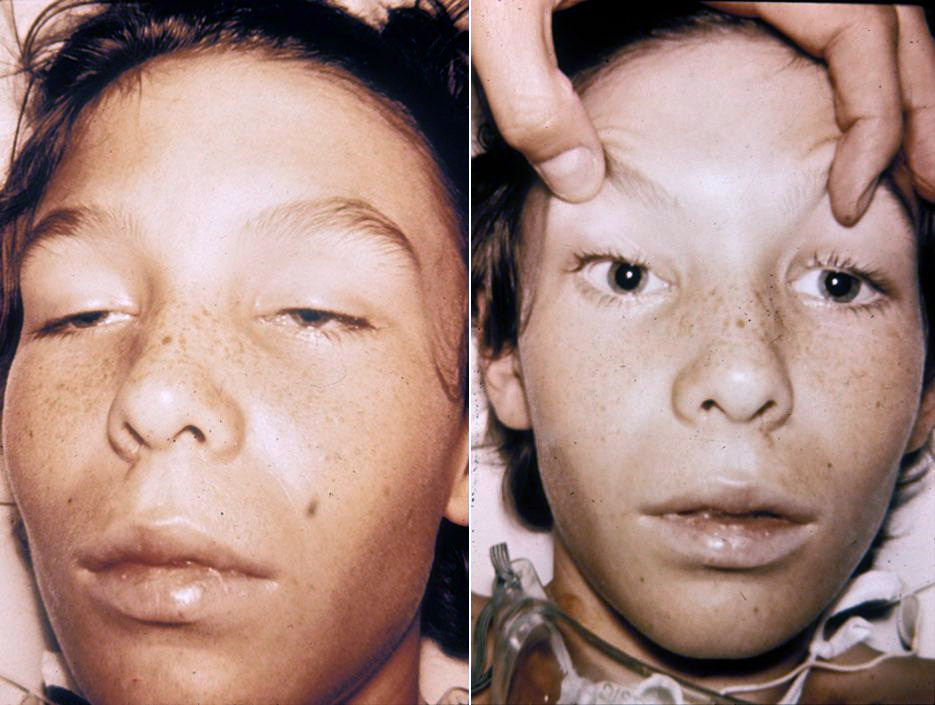What is Botulism

What is Botulism
Botulism is a potentially life-threatening illness resulting from INFECTION with the anaerobic bacterium Clostridium botulinum. The BACTERIA are naturally present in soil, where they encase themselves in spores. In the body, the bacteria release a toxin that blocks the release of acetylcholine, a NEUROTRANSMITTER that facilitates NERVE impulses from neurons to MUSCLE cells, causing PARALYSIS that may range in severity from mild to lifethreatening. There are three types of botulism:
- Foodborne botulism results from eating improperly canned or cooked foods contaminated with C. botulinum spores. Because the bacteria are anaerobic, they thrive in the relatively oxygen-free environment of canned, bottled, or otherwise contained foods. Foodborne botulism most commonly causes gastrointestinal symptoms such as abdominal cramping and DIARRHEA, though can cause systemic symptoms that may include paralysis of the chest muscles.
- Wound botulism develops in traumatic injury wounds that close over after the injury, trapping bacteria within them. Usually the injury involves some sort of contact with soil. This type of botulism can result in the infection commonly called gas GANGRENE. Often treatment requires surgery to open and clean the wound, removing damaged and dead tissue, along with administration of intravenous ANTIBIOTIC MEDICATIONS.
- Infant botulism occurs in children under age one year whose gastrointestinal tracts are not fully developed. The most common source of C. botulinum that causes infant botulism is unpasteurized honey. In an older child or adult the NORMAL FLORA and environment of the gastrointestinal tract would neutralize the few C. botulinum spores honey typically contains, but the infant’s system lacks the maturity to do this.
Symptoms of Botulism and Diagnostic Path
Symptoms begin 2 to 10 days after exposure. Early neurologic symptoms include vision disturbances, difficulty swallowing and speaking, and drooping eyelids (PTOSIS). As the infection progresses, paralysis may develop throughout the body. In foodborne botulism symptoms also include NAUSEA, VOMITING, and diarrhea. In wound botulism, there may also be PAIN and swelling at the wound site though usually the wound appears normal.
The diagnostic path includes a comprehensive NEUROLOGIC EXAMINATION and testing for the presence of C. botulinum in either a stool sample or sample of the suspected food source.
Botulism Treatment Options and Outlook
Treatment in older children and adults is hospitalization and prompt administration of trivalent ABE ANTITOXIN to counter the effects of the toxin the C. botulinum bacteria produce. Additional treatment for wound botulism is intravenous antibiotics, usually high doses of penicillin or clindamycin. Treatment for infant botulism is the antibiotic amoxicillin. With prompt and appropriate treatment many people fully recover from botulism, though some people have weakness, paralysis, or other neurologic symptoms.
Risk Factors and Preventive Measures
C. botulinum spores are present in soil and thus can contaminate vegetables and fruits. The risk for infection occurs with improperly canned or processed foods because the C. botulinum bacteria thrive and vastly multiply in the anaerobic environment. It is not possible to detect their presence by the appearance, smell, or taste of the contaminated food, though often the can or jar lid bulges. Home-canned foods are more commonly the source of foodborne botulism. Infants under one year should not eat honey or foods that contain honey, as unpasteurized honey is a common source of C. botulinum spores that are not a health risk to adults but can cause illness in infants. Wound botulism may develop even when the person takes antibiotics because the broad-spectrum antibiotics typically prescribed are not effective against C. botulinum. Diligent cleansing of injuries that have soil contamination reduces the risk for wound botulism.
See also ANTIBIOTIC MEDICATIONS; BOTULINUM THERAPY; FOODBORNE ILLNESSES; FOOD SAFETY; GUILLAINBARRÉ SYNDROME; NEURON; WATERBORNE ILLNESSES.
Open discussion on the topic What is Botulism - causes, symptoms and treatment Botulism
Similar interests
- Casino Non Aams
- Nuovi Casino
- Casinos Not On Gamstop
- UK Casinos Not On Gamstop
- Casinos Not On Gamstop
- UK Casinos Not On Gamstop
- Casino Non Aams Italia
- Slot Sites Not On Gamstop
- Meilleur Casino En Ligne
- Non Gamstop Casino Sites UK
- Meilleur Casino En Ligne
- Casino En Ligne France
- Best Non Gamstop Casinos
- Casinos Not On Gamstop
- UK Casino Not On Gamstop
- Casinos Not Signed Up To Gamstop
- Best Slot Sites UK
- Non Gamstop Casino Sites UK
- Online Casinos Nederland
- Online Casinos Nederland
- Casinos Not On Gamstop
- Best New Uk Casinos Not On Gamstop
- Casino Non Aams
- Non Gamstop Casinos UK
- Migliori Siti Casino Non Aams
- Bitcoin Casinos
- Sites De Paris Sportifs Belgique
- Bookmaker Non Aams
- Casino En Ligne
- Casino Nouveau En Ligne